Auditing Report: Audit Evidence, Financial Ratios, and Risk Analysis
VerifiedAdded on 2023/01/06
|12
|3700
|32
Report
AI Summary
This auditing report presents a comprehensive analysis of key auditing concepts. It begins with an introduction to auditing and then delves into the importance of sufficient and appropriate audit evidence, supported by a case study. The report examines the implications of financial ratios in auditing, analyzing ratios like current ratio, quick ratio, inventory turnover, and net profit margin. Internal control weaknesses within a case study are identified, focusing on segregation of duties and authorization processes. The report evaluates the appropriateness of conclusions drawn by auditors and discusses the risks associated with related party transactions, including material misstatement and fraud. Finally, it explores procedures for managing assertions and compares the roles of internal and external auditors. The report draws conclusions and provides references to support its findings.

AUDITING
Secure Best Marks with AI Grader
Need help grading? Try our AI Grader for instant feedback on your assignments.
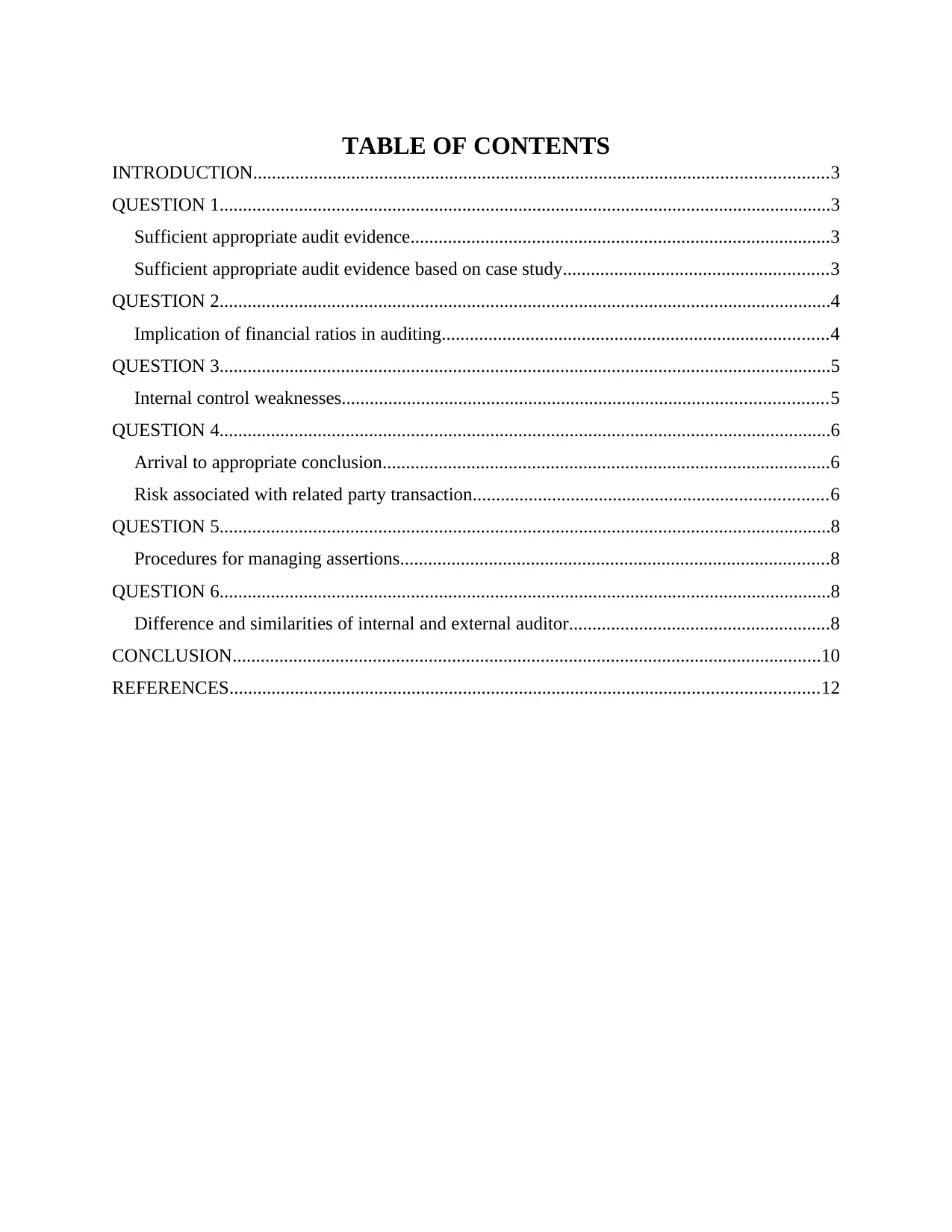
TABLE OF CONTENTS
INTRODUCTION...........................................................................................................................3
QUESTION 1...................................................................................................................................3
Sufficient appropriate audit evidence..........................................................................................3
Sufficient appropriate audit evidence based on case study.........................................................3
QUESTION 2...................................................................................................................................4
Implication of financial ratios in auditing...................................................................................4
QUESTION 3...................................................................................................................................5
Internal control weaknesses........................................................................................................5
QUESTION 4...................................................................................................................................6
Arrival to appropriate conclusion................................................................................................6
Risk associated with related party transaction............................................................................6
QUESTION 5...................................................................................................................................8
Procedures for managing assertions............................................................................................8
QUESTION 6...................................................................................................................................8
Difference and similarities of internal and external auditor........................................................8
CONCLUSION..............................................................................................................................10
REFERENCES..............................................................................................................................12
INTRODUCTION...........................................................................................................................3
QUESTION 1...................................................................................................................................3
Sufficient appropriate audit evidence..........................................................................................3
Sufficient appropriate audit evidence based on case study.........................................................3
QUESTION 2...................................................................................................................................4
Implication of financial ratios in auditing...................................................................................4
QUESTION 3...................................................................................................................................5
Internal control weaknesses........................................................................................................5
QUESTION 4...................................................................................................................................6
Arrival to appropriate conclusion................................................................................................6
Risk associated with related party transaction............................................................................6
QUESTION 5...................................................................................................................................8
Procedures for managing assertions............................................................................................8
QUESTION 6...................................................................................................................................8
Difference and similarities of internal and external auditor........................................................8
CONCLUSION..............................................................................................................................10
REFERENCES..............................................................................................................................12
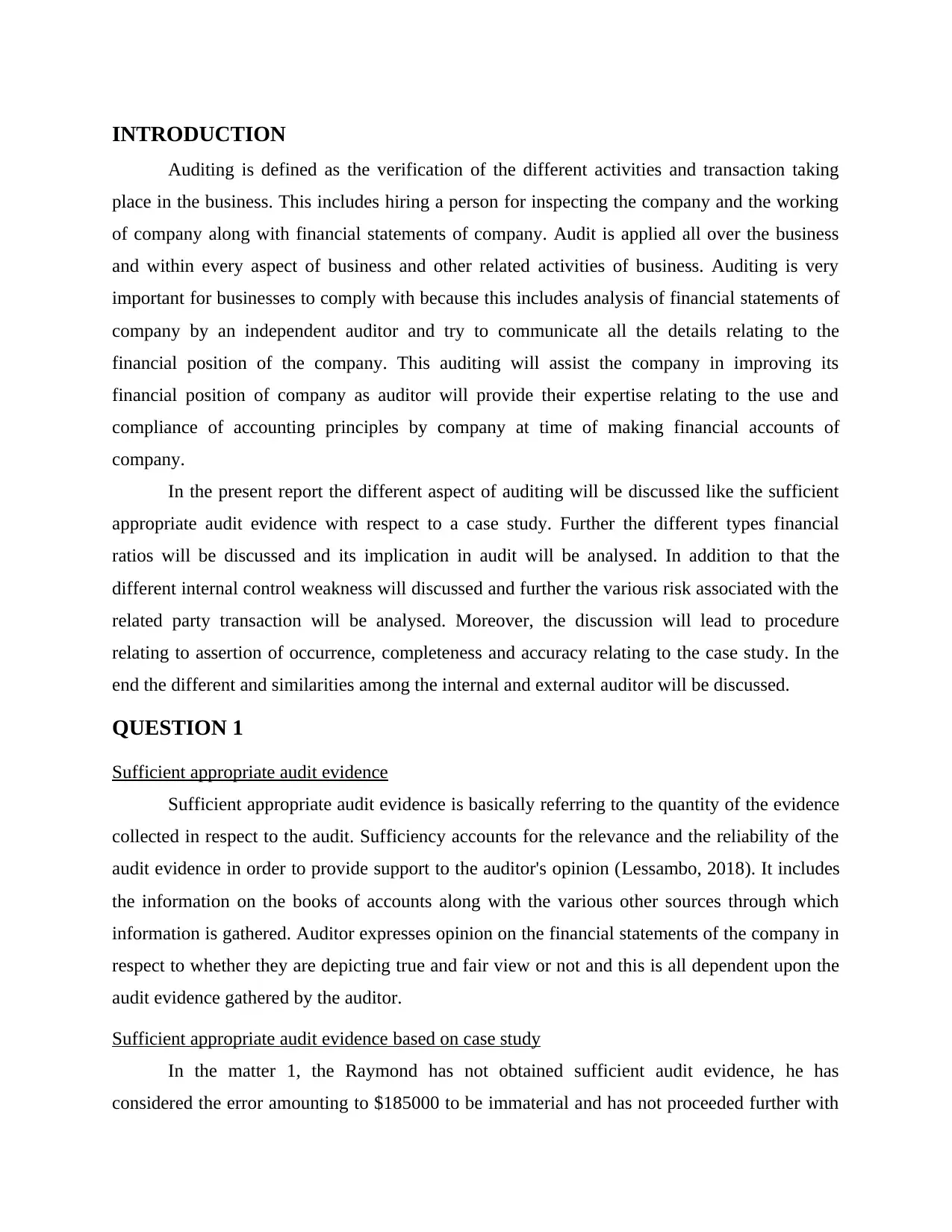
INTRODUCTION
Auditing is defined as the verification of the different activities and transaction taking
place in the business. This includes hiring a person for inspecting the company and the working
of company along with financial statements of company. Audit is applied all over the business
and within every aspect of business and other related activities of business. Auditing is very
important for businesses to comply with because this includes analysis of financial statements of
company by an independent auditor and try to communicate all the details relating to the
financial position of the company. This auditing will assist the company in improving its
financial position of company as auditor will provide their expertise relating to the use and
compliance of accounting principles by company at time of making financial accounts of
company.
In the present report the different aspect of auditing will be discussed like the sufficient
appropriate audit evidence with respect to a case study. Further the different types financial
ratios will be discussed and its implication in audit will be analysed. In addition to that the
different internal control weakness will discussed and further the various risk associated with the
related party transaction will be analysed. Moreover, the discussion will lead to procedure
relating to assertion of occurrence, completeness and accuracy relating to the case study. In the
end the different and similarities among the internal and external auditor will be discussed.
QUESTION 1
Sufficient appropriate audit evidence
Sufficient appropriate audit evidence is basically referring to the quantity of the evidence
collected in respect to the audit. Sufficiency accounts for the relevance and the reliability of the
audit evidence in order to provide support to the auditor's opinion (Lessambo, 2018). It includes
the information on the books of accounts along with the various other sources through which
information is gathered. Auditor expresses opinion on the financial statements of the company in
respect to whether they are depicting true and fair view or not and this is all dependent upon the
audit evidence gathered by the auditor.
Sufficient appropriate audit evidence based on case study
In the matter 1, the Raymond has not obtained sufficient audit evidence, he has
considered the error amounting to $185000 to be immaterial and has not proceeded further with
Auditing is defined as the verification of the different activities and transaction taking
place in the business. This includes hiring a person for inspecting the company and the working
of company along with financial statements of company. Audit is applied all over the business
and within every aspect of business and other related activities of business. Auditing is very
important for businesses to comply with because this includes analysis of financial statements of
company by an independent auditor and try to communicate all the details relating to the
financial position of the company. This auditing will assist the company in improving its
financial position of company as auditor will provide their expertise relating to the use and
compliance of accounting principles by company at time of making financial accounts of
company.
In the present report the different aspect of auditing will be discussed like the sufficient
appropriate audit evidence with respect to a case study. Further the different types financial
ratios will be discussed and its implication in audit will be analysed. In addition to that the
different internal control weakness will discussed and further the various risk associated with the
related party transaction will be analysed. Moreover, the discussion will lead to procedure
relating to assertion of occurrence, completeness and accuracy relating to the case study. In the
end the different and similarities among the internal and external auditor will be discussed.
QUESTION 1
Sufficient appropriate audit evidence
Sufficient appropriate audit evidence is basically referring to the quantity of the evidence
collected in respect to the audit. Sufficiency accounts for the relevance and the reliability of the
audit evidence in order to provide support to the auditor's opinion (Lessambo, 2018). It includes
the information on the books of accounts along with the various other sources through which
information is gathered. Auditor expresses opinion on the financial statements of the company in
respect to whether they are depicting true and fair view or not and this is all dependent upon the
audit evidence gathered by the auditor.
Sufficient appropriate audit evidence based on case study
In the matter 1, the Raymond has not obtained sufficient audit evidence, he has
considered the error amounting to $185000 to be immaterial and has not proceeded further with
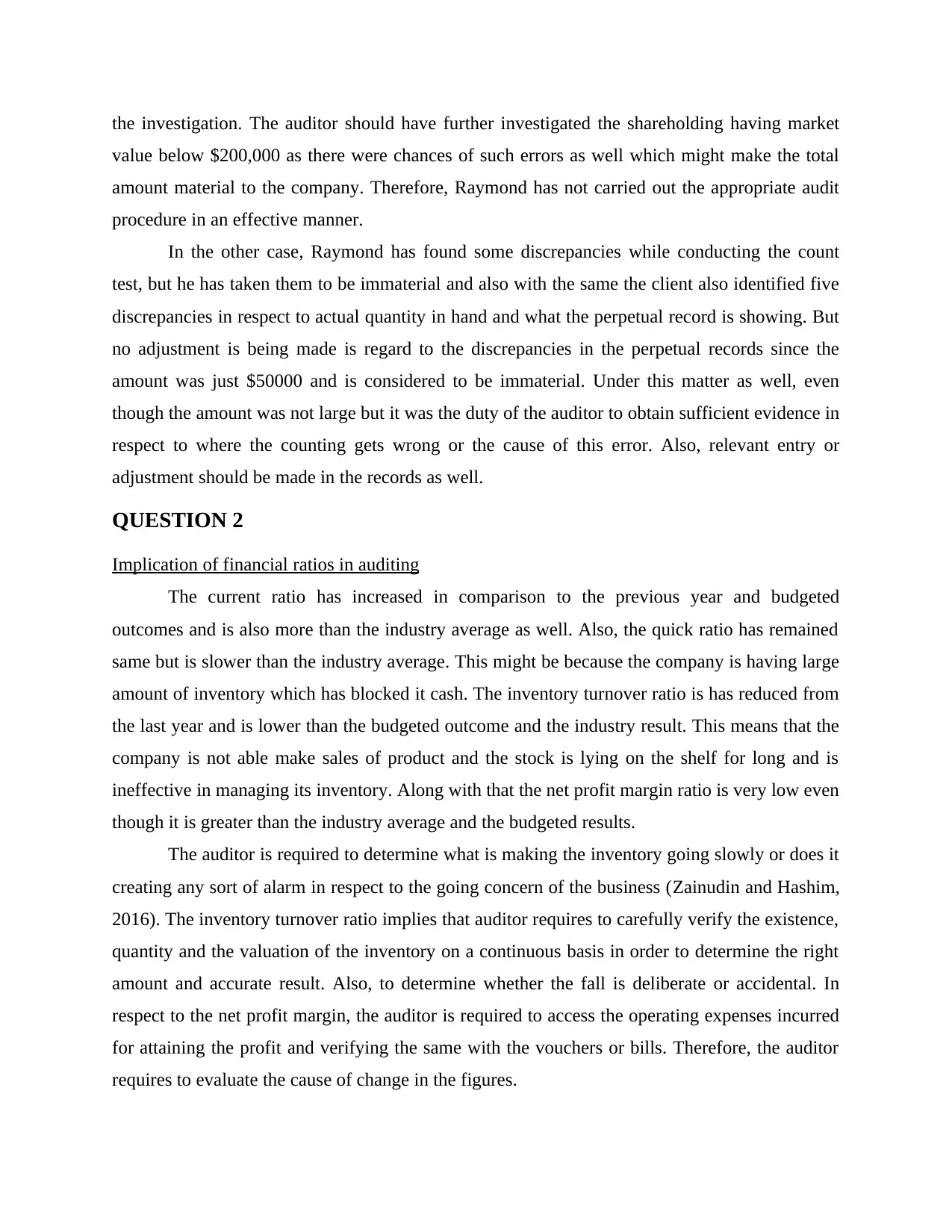
the investigation. The auditor should have further investigated the shareholding having market
value below $200,000 as there were chances of such errors as well which might make the total
amount material to the company. Therefore, Raymond has not carried out the appropriate audit
procedure in an effective manner.
In the other case, Raymond has found some discrepancies while conducting the count
test, but he has taken them to be immaterial and also with the same the client also identified five
discrepancies in respect to actual quantity in hand and what the perpetual record is showing. But
no adjustment is being made is regard to the discrepancies in the perpetual records since the
amount was just $50000 and is considered to be immaterial. Under this matter as well, even
though the amount was not large but it was the duty of the auditor to obtain sufficient evidence in
respect to where the counting gets wrong or the cause of this error. Also, relevant entry or
adjustment should be made in the records as well.
QUESTION 2
Implication of financial ratios in auditing
The current ratio has increased in comparison to the previous year and budgeted
outcomes and is also more than the industry average as well. Also, the quick ratio has remained
same but is slower than the industry average. This might be because the company is having large
amount of inventory which has blocked it cash. The inventory turnover ratio is has reduced from
the last year and is lower than the budgeted outcome and the industry result. This means that the
company is not able make sales of product and the stock is lying on the shelf for long and is
ineffective in managing its inventory. Along with that the net profit margin ratio is very low even
though it is greater than the industry average and the budgeted results.
The auditor is required to determine what is making the inventory going slowly or does it
creating any sort of alarm in respect to the going concern of the business (Zainudin and Hashim,
2016). The inventory turnover ratio implies that auditor requires to carefully verify the existence,
quantity and the valuation of the inventory on a continuous basis in order to determine the right
amount and accurate result. Also, to determine whether the fall is deliberate or accidental. In
respect to the net profit margin, the auditor is required to access the operating expenses incurred
for attaining the profit and verifying the same with the vouchers or bills. Therefore, the auditor
requires to evaluate the cause of change in the figures.
value below $200,000 as there were chances of such errors as well which might make the total
amount material to the company. Therefore, Raymond has not carried out the appropriate audit
procedure in an effective manner.
In the other case, Raymond has found some discrepancies while conducting the count
test, but he has taken them to be immaterial and also with the same the client also identified five
discrepancies in respect to actual quantity in hand and what the perpetual record is showing. But
no adjustment is being made is regard to the discrepancies in the perpetual records since the
amount was just $50000 and is considered to be immaterial. Under this matter as well, even
though the amount was not large but it was the duty of the auditor to obtain sufficient evidence in
respect to where the counting gets wrong or the cause of this error. Also, relevant entry or
adjustment should be made in the records as well.
QUESTION 2
Implication of financial ratios in auditing
The current ratio has increased in comparison to the previous year and budgeted
outcomes and is also more than the industry average as well. Also, the quick ratio has remained
same but is slower than the industry average. This might be because the company is having large
amount of inventory which has blocked it cash. The inventory turnover ratio is has reduced from
the last year and is lower than the budgeted outcome and the industry result. This means that the
company is not able make sales of product and the stock is lying on the shelf for long and is
ineffective in managing its inventory. Along with that the net profit margin ratio is very low even
though it is greater than the industry average and the budgeted results.
The auditor is required to determine what is making the inventory going slowly or does it
creating any sort of alarm in respect to the going concern of the business (Zainudin and Hashim,
2016). The inventory turnover ratio implies that auditor requires to carefully verify the existence,
quantity and the valuation of the inventory on a continuous basis in order to determine the right
amount and accurate result. Also, to determine whether the fall is deliberate or accidental. In
respect to the net profit margin, the auditor is required to access the operating expenses incurred
for attaining the profit and verifying the same with the vouchers or bills. Therefore, the auditor
requires to evaluate the cause of change in the figures.
Secure Best Marks with AI Grader
Need help grading? Try our AI Grader for instant feedback on your assignments.
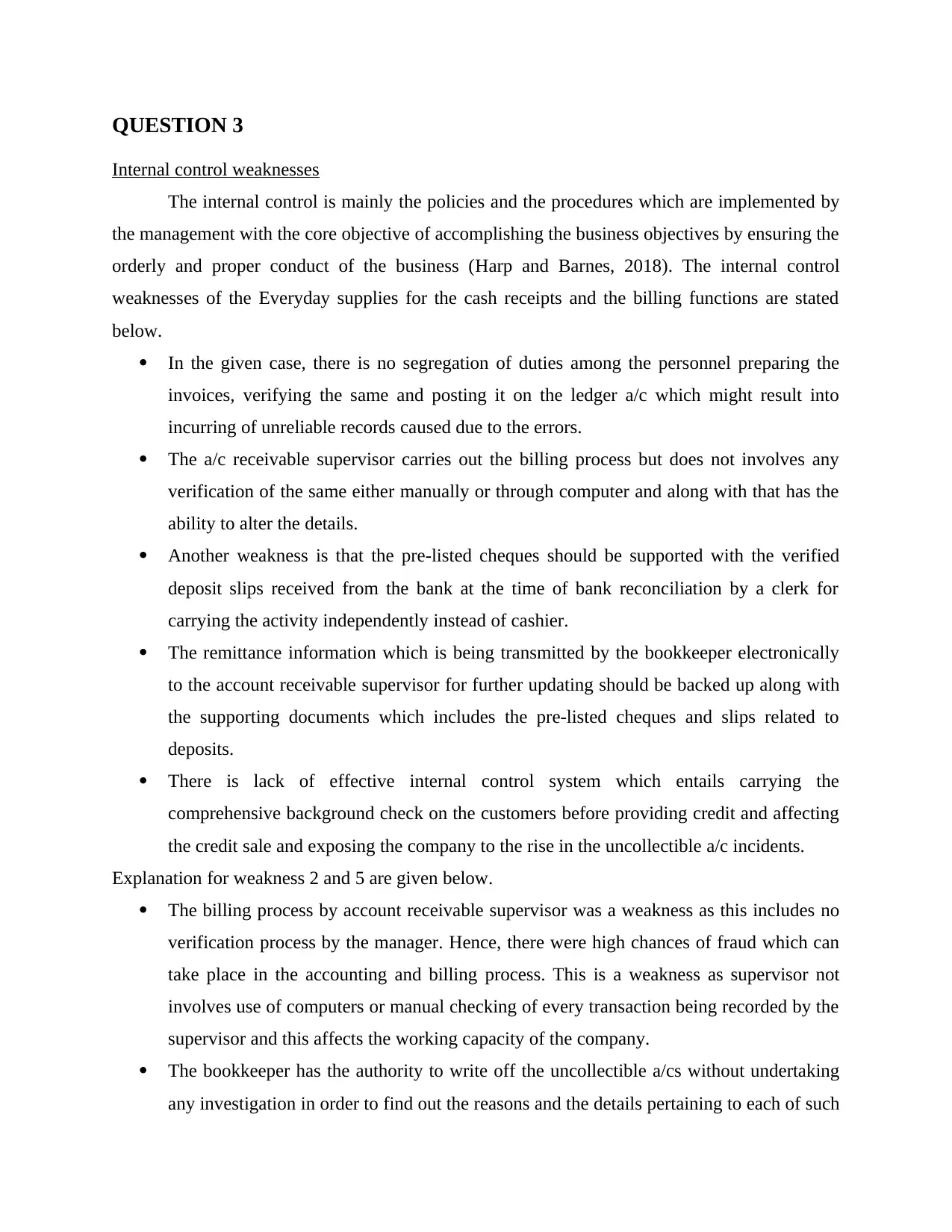
QUESTION 3
Internal control weaknesses
The internal control is mainly the policies and the procedures which are implemented by
the management with the core objective of accomplishing the business objectives by ensuring the
orderly and proper conduct of the business (Harp and Barnes, 2018). The internal control
weaknesses of the Everyday supplies for the cash receipts and the billing functions are stated
below.
In the given case, there is no segregation of duties among the personnel preparing the
invoices, verifying the same and posting it on the ledger a/c which might result into
incurring of unreliable records caused due to the errors.
The a/c receivable supervisor carries out the billing process but does not involves any
verification of the same either manually or through computer and along with that has the
ability to alter the details.
Another weakness is that the pre-listed cheques should be supported with the verified
deposit slips received from the bank at the time of bank reconciliation by a clerk for
carrying the activity independently instead of cashier.
The remittance information which is being transmitted by the bookkeeper electronically
to the account receivable supervisor for further updating should be backed up along with
the supporting documents which includes the pre-listed cheques and slips related to
deposits.
There is lack of effective internal control system which entails carrying the
comprehensive background check on the customers before providing credit and affecting
the credit sale and exposing the company to the rise in the uncollectible a/c incidents.
Explanation for weakness 2 and 5 are given below.
The billing process by account receivable supervisor was a weakness as this includes no
verification process by the manager. Hence, there were high chances of fraud which can
take place in the accounting and billing process. This is a weakness as supervisor not
involves use of computers or manual checking of every transaction being recorded by the
supervisor and this affects the working capacity of the company.
The bookkeeper has the authority to write off the uncollectible a/cs without undertaking
any investigation in order to find out the reasons and the details pertaining to each of such
Internal control weaknesses
The internal control is mainly the policies and the procedures which are implemented by
the management with the core objective of accomplishing the business objectives by ensuring the
orderly and proper conduct of the business (Harp and Barnes, 2018). The internal control
weaknesses of the Everyday supplies for the cash receipts and the billing functions are stated
below.
In the given case, there is no segregation of duties among the personnel preparing the
invoices, verifying the same and posting it on the ledger a/c which might result into
incurring of unreliable records caused due to the errors.
The a/c receivable supervisor carries out the billing process but does not involves any
verification of the same either manually or through computer and along with that has the
ability to alter the details.
Another weakness is that the pre-listed cheques should be supported with the verified
deposit slips received from the bank at the time of bank reconciliation by a clerk for
carrying the activity independently instead of cashier.
The remittance information which is being transmitted by the bookkeeper electronically
to the account receivable supervisor for further updating should be backed up along with
the supporting documents which includes the pre-listed cheques and slips related to
deposits.
There is lack of effective internal control system which entails carrying the
comprehensive background check on the customers before providing credit and affecting
the credit sale and exposing the company to the rise in the uncollectible a/c incidents.
Explanation for weakness 2 and 5 are given below.
The billing process by account receivable supervisor was a weakness as this includes no
verification process by the manager. Hence, there were high chances of fraud which can
take place in the accounting and billing process. This is a weakness as supervisor not
involves use of computers or manual checking of every transaction being recorded by the
supervisor and this affects the working capacity of the company.
The bookkeeper has the authority to write off the uncollectible a/cs without undertaking
any investigation in order to find out the reasons and the details pertaining to each of such
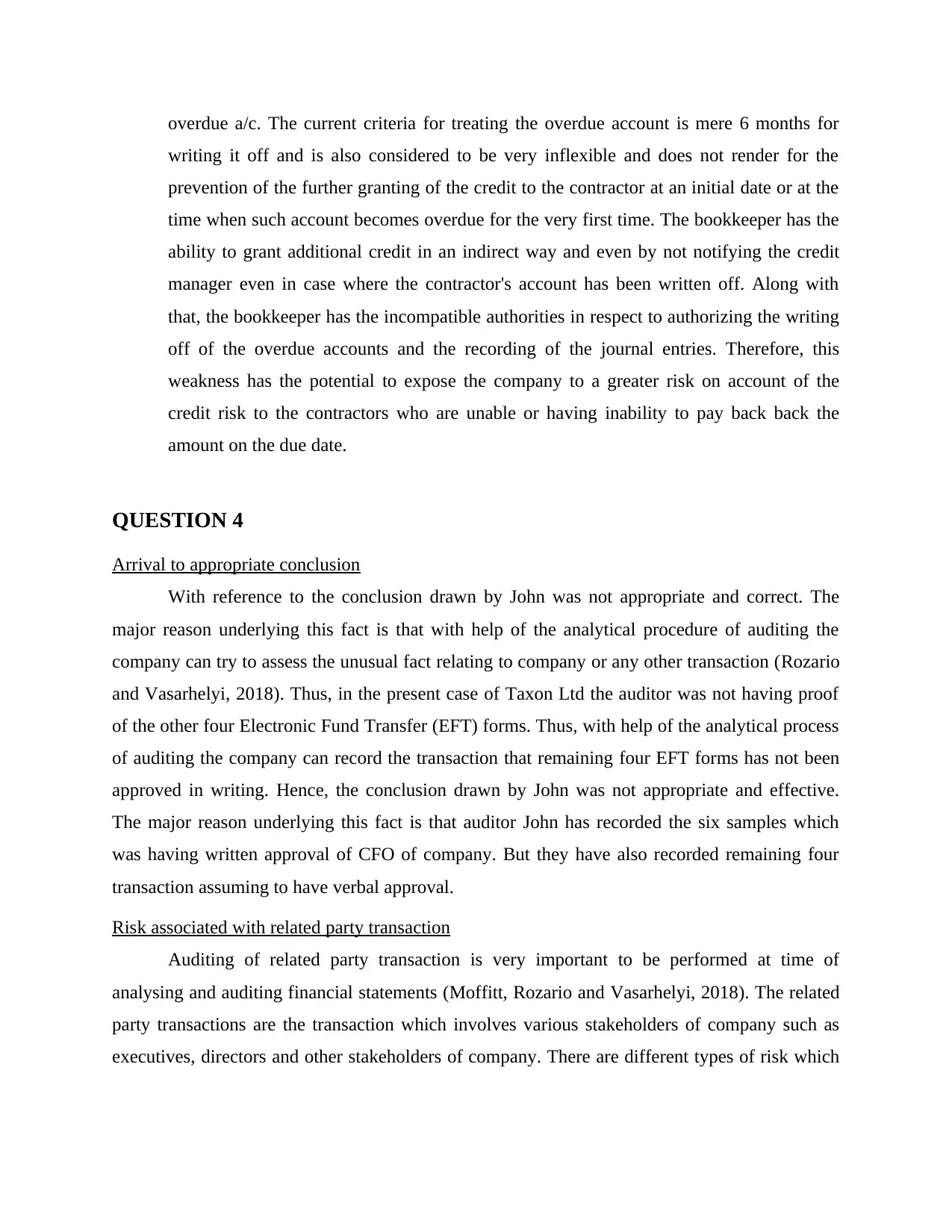
overdue a/c. The current criteria for treating the overdue account is mere 6 months for
writing it off and is also considered to be very inflexible and does not render for the
prevention of the further granting of the credit to the contractor at an initial date or at the
time when such account becomes overdue for the very first time. The bookkeeper has the
ability to grant additional credit in an indirect way and even by not notifying the credit
manager even in case where the contractor's account has been written off. Along with
that, the bookkeeper has the incompatible authorities in respect to authorizing the writing
off of the overdue accounts and the recording of the journal entries. Therefore, this
weakness has the potential to expose the company to a greater risk on account of the
credit risk to the contractors who are unable or having inability to pay back back the
amount on the due date.
QUESTION 4
Arrival to appropriate conclusion
With reference to the conclusion drawn by John was not appropriate and correct. The
major reason underlying this fact is that with help of the analytical procedure of auditing the
company can try to assess the unusual fact relating to company or any other transaction (Rozario
and Vasarhelyi, 2018). Thus, in the present case of Taxon Ltd the auditor was not having proof
of the other four Electronic Fund Transfer (EFT) forms. Thus, with help of the analytical process
of auditing the company can record the transaction that remaining four EFT forms has not been
approved in writing. Hence, the conclusion drawn by John was not appropriate and effective.
The major reason underlying this fact is that auditor John has recorded the six samples which
was having written approval of CFO of company. But they have also recorded remaining four
transaction assuming to have verbal approval.
Risk associated with related party transaction
Auditing of related party transaction is very important to be performed at time of
analysing and auditing financial statements (Moffitt, Rozario and Vasarhelyi, 2018). The related
party transactions are the transaction which involves various stakeholders of company such as
executives, directors and other stakeholders of company. There are different types of risk which
writing it off and is also considered to be very inflexible and does not render for the
prevention of the further granting of the credit to the contractor at an initial date or at the
time when such account becomes overdue for the very first time. The bookkeeper has the
ability to grant additional credit in an indirect way and even by not notifying the credit
manager even in case where the contractor's account has been written off. Along with
that, the bookkeeper has the incompatible authorities in respect to authorizing the writing
off of the overdue accounts and the recording of the journal entries. Therefore, this
weakness has the potential to expose the company to a greater risk on account of the
credit risk to the contractors who are unable or having inability to pay back back the
amount on the due date.
QUESTION 4
Arrival to appropriate conclusion
With reference to the conclusion drawn by John was not appropriate and correct. The
major reason underlying this fact is that with help of the analytical procedure of auditing the
company can try to assess the unusual fact relating to company or any other transaction (Rozario
and Vasarhelyi, 2018). Thus, in the present case of Taxon Ltd the auditor was not having proof
of the other four Electronic Fund Transfer (EFT) forms. Thus, with help of the analytical process
of auditing the company can record the transaction that remaining four EFT forms has not been
approved in writing. Hence, the conclusion drawn by John was not appropriate and effective.
The major reason underlying this fact is that auditor John has recorded the six samples which
was having written approval of CFO of company. But they have also recorded remaining four
transaction assuming to have verbal approval.
Risk associated with related party transaction
Auditing of related party transaction is very important to be performed at time of
analysing and auditing financial statements (Moffitt, Rozario and Vasarhelyi, 2018). The related
party transactions are the transaction which involves various stakeholders of company such as
executives, directors and other stakeholders of company. There are different types of risk which
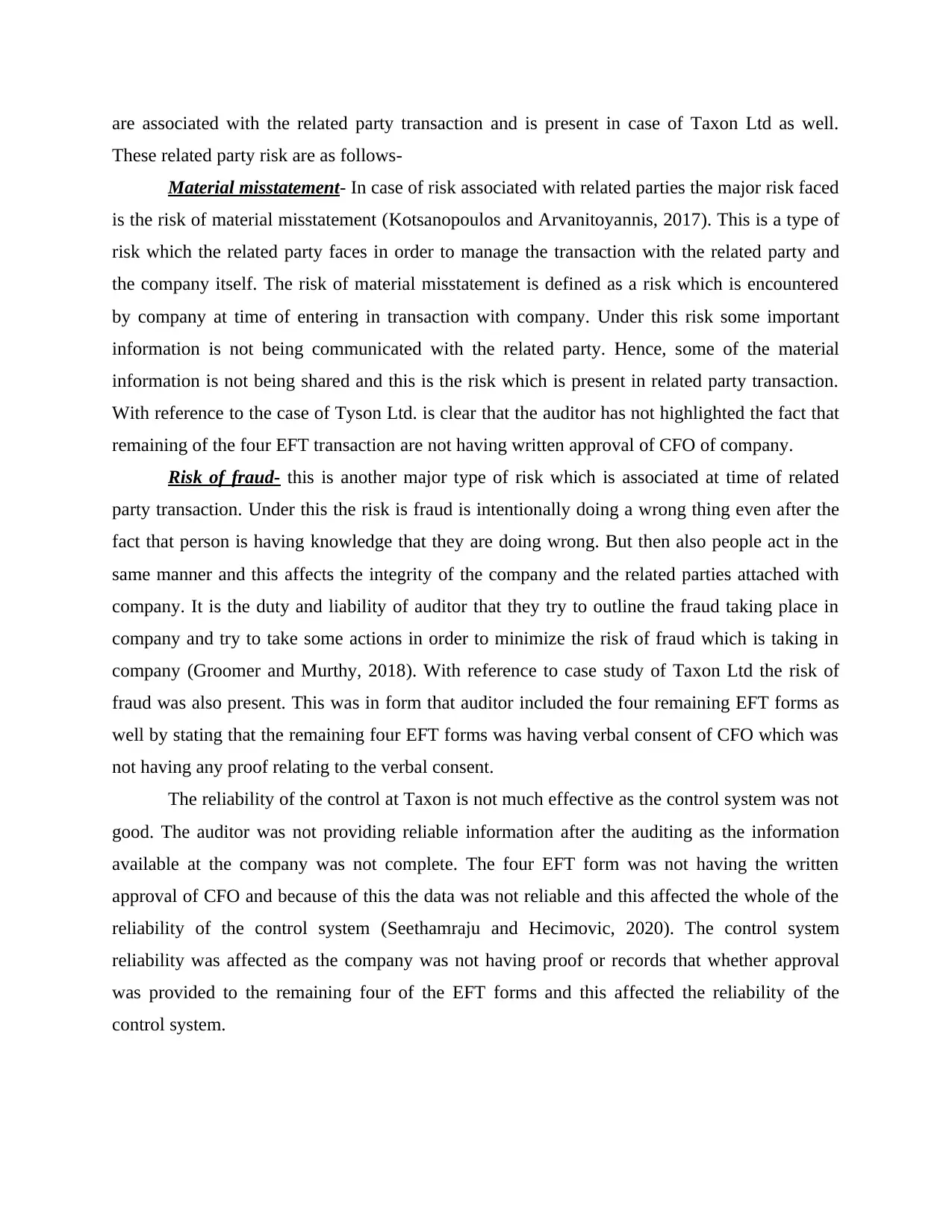
are associated with the related party transaction and is present in case of Taxon Ltd as well.
These related party risk are as follows-
Material misstatement- In case of risk associated with related parties the major risk faced
is the risk of material misstatement (Kotsanopoulos and Arvanitoyannis, 2017). This is a type of
risk which the related party faces in order to manage the transaction with the related party and
the company itself. The risk of material misstatement is defined as a risk which is encountered
by company at time of entering in transaction with company. Under this risk some important
information is not being communicated with the related party. Hence, some of the material
information is not being shared and this is the risk which is present in related party transaction.
With reference to the case of Tyson Ltd. is clear that the auditor has not highlighted the fact that
remaining of the four EFT transaction are not having written approval of CFO of company.
Risk of fraud- this is another major type of risk which is associated at time of related
party transaction. Under this the risk is fraud is intentionally doing a wrong thing even after the
fact that person is having knowledge that they are doing wrong. But then also people act in the
same manner and this affects the integrity of the company and the related parties attached with
company. It is the duty and liability of auditor that they try to outline the fraud taking place in
company and try to take some actions in order to minimize the risk of fraud which is taking in
company (Groomer and Murthy, 2018). With reference to case study of Taxon Ltd the risk of
fraud was also present. This was in form that auditor included the four remaining EFT forms as
well by stating that the remaining four EFT forms was having verbal consent of CFO which was
not having any proof relating to the verbal consent.
The reliability of the control at Taxon is not much effective as the control system was not
good. The auditor was not providing reliable information after the auditing as the information
available at the company was not complete. The four EFT form was not having the written
approval of CFO and because of this the data was not reliable and this affected the whole of the
reliability of the control system (Seethamraju and Hecimovic, 2020). The control system
reliability was affected as the company was not having proof or records that whether approval
was provided to the remaining four of the EFT forms and this affected the reliability of the
control system.
These related party risk are as follows-
Material misstatement- In case of risk associated with related parties the major risk faced
is the risk of material misstatement (Kotsanopoulos and Arvanitoyannis, 2017). This is a type of
risk which the related party faces in order to manage the transaction with the related party and
the company itself. The risk of material misstatement is defined as a risk which is encountered
by company at time of entering in transaction with company. Under this risk some important
information is not being communicated with the related party. Hence, some of the material
information is not being shared and this is the risk which is present in related party transaction.
With reference to the case of Tyson Ltd. is clear that the auditor has not highlighted the fact that
remaining of the four EFT transaction are not having written approval of CFO of company.
Risk of fraud- this is another major type of risk which is associated at time of related
party transaction. Under this the risk is fraud is intentionally doing a wrong thing even after the
fact that person is having knowledge that they are doing wrong. But then also people act in the
same manner and this affects the integrity of the company and the related parties attached with
company. It is the duty and liability of auditor that they try to outline the fraud taking place in
company and try to take some actions in order to minimize the risk of fraud which is taking in
company (Groomer and Murthy, 2018). With reference to case study of Taxon Ltd the risk of
fraud was also present. This was in form that auditor included the four remaining EFT forms as
well by stating that the remaining four EFT forms was having verbal consent of CFO which was
not having any proof relating to the verbal consent.
The reliability of the control at Taxon is not much effective as the control system was not
good. The auditor was not providing reliable information after the auditing as the information
available at the company was not complete. The four EFT form was not having the written
approval of CFO and because of this the data was not reliable and this affected the whole of the
reliability of the control system (Seethamraju and Hecimovic, 2020). The control system
reliability was affected as the company was not having proof or records that whether approval
was provided to the remaining four of the EFT forms and this affected the reliability of the
control system.
Paraphrase This Document
Need a fresh take? Get an instant paraphrase of this document with our AI Paraphraser
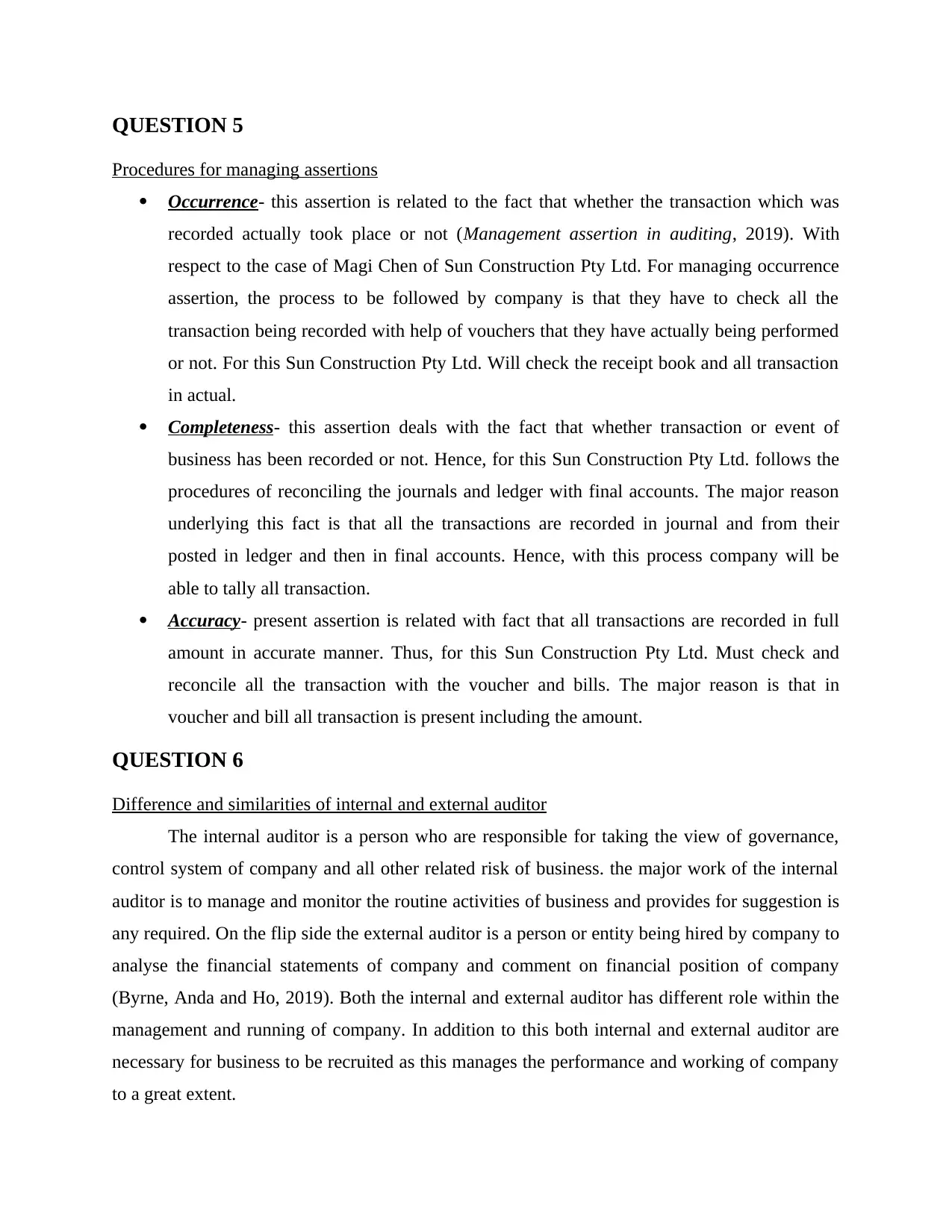
QUESTION 5
Procedures for managing assertions
Occurrence- this assertion is related to the fact that whether the transaction which was
recorded actually took place or not (Management assertion in auditing, 2019). With
respect to the case of Magi Chen of Sun Construction Pty Ltd. For managing occurrence
assertion, the process to be followed by company is that they have to check all the
transaction being recorded with help of vouchers that they have actually being performed
or not. For this Sun Construction Pty Ltd. Will check the receipt book and all transaction
in actual.
Completeness- this assertion deals with the fact that whether transaction or event of
business has been recorded or not. Hence, for this Sun Construction Pty Ltd. follows the
procedures of reconciling the journals and ledger with final accounts. The major reason
underlying this fact is that all the transactions are recorded in journal and from their
posted in ledger and then in final accounts. Hence, with this process company will be
able to tally all transaction.
Accuracy- present assertion is related with fact that all transactions are recorded in full
amount in accurate manner. Thus, for this Sun Construction Pty Ltd. Must check and
reconcile all the transaction with the voucher and bills. The major reason is that in
voucher and bill all transaction is present including the amount.
QUESTION 6
Difference and similarities of internal and external auditor
The internal auditor is a person who are responsible for taking the view of governance,
control system of company and all other related risk of business. the major work of the internal
auditor is to manage and monitor the routine activities of business and provides for suggestion is
any required. On the flip side the external auditor is a person or entity being hired by company to
analyse the financial statements of company and comment on financial position of company
(Byrne, Anda and Ho, 2019). Both the internal and external auditor has different role within the
management and running of company. In addition to this both internal and external auditor are
necessary for business to be recruited as this manages the performance and working of company
to a great extent.
Procedures for managing assertions
Occurrence- this assertion is related to the fact that whether the transaction which was
recorded actually took place or not (Management assertion in auditing, 2019). With
respect to the case of Magi Chen of Sun Construction Pty Ltd. For managing occurrence
assertion, the process to be followed by company is that they have to check all the
transaction being recorded with help of vouchers that they have actually being performed
or not. For this Sun Construction Pty Ltd. Will check the receipt book and all transaction
in actual.
Completeness- this assertion deals with the fact that whether transaction or event of
business has been recorded or not. Hence, for this Sun Construction Pty Ltd. follows the
procedures of reconciling the journals and ledger with final accounts. The major reason
underlying this fact is that all the transactions are recorded in journal and from their
posted in ledger and then in final accounts. Hence, with this process company will be
able to tally all transaction.
Accuracy- present assertion is related with fact that all transactions are recorded in full
amount in accurate manner. Thus, for this Sun Construction Pty Ltd. Must check and
reconcile all the transaction with the voucher and bills. The major reason is that in
voucher and bill all transaction is present including the amount.
QUESTION 6
Difference and similarities of internal and external auditor
The internal auditor is a person who are responsible for taking the view of governance,
control system of company and all other related risk of business. the major work of the internal
auditor is to manage and monitor the routine activities of business and provides for suggestion is
any required. On the flip side the external auditor is a person or entity being hired by company to
analyse the financial statements of company and comment on financial position of company
(Byrne, Anda and Ho, 2019). Both the internal and external auditor has different role within the
management and running of company. In addition to this both internal and external auditor are
necessary for business to be recruited as this manages the performance and working of company
to a great extent.
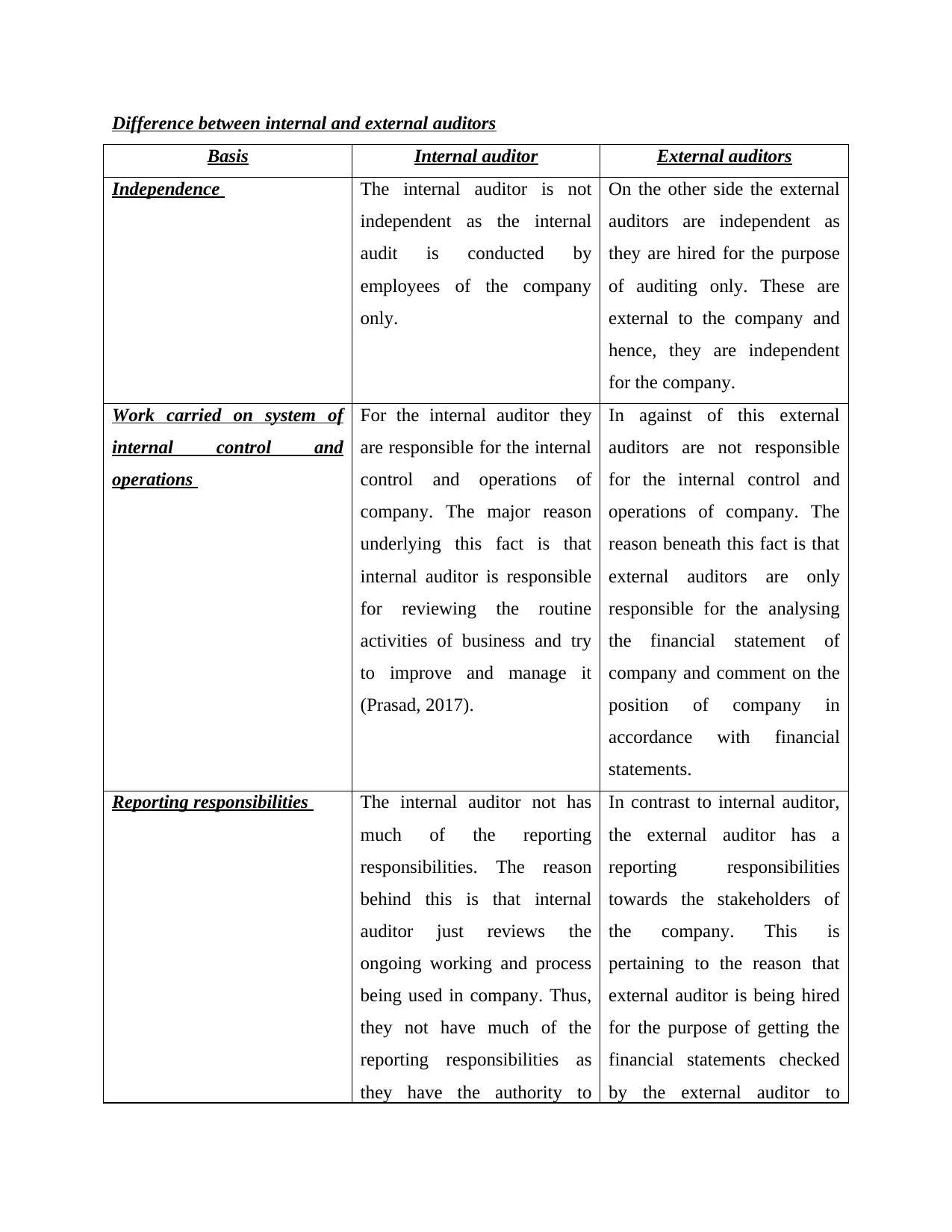
Difference between internal and external auditors
Basis Internal auditor External auditors
Independence The internal auditor is not
independent as the internal
audit is conducted by
employees of the company
only.
On the other side the external
auditors are independent as
they are hired for the purpose
of auditing only. These are
external to the company and
hence, they are independent
for the company.
Work carried on system of
internal control and
operations
For the internal auditor they
are responsible for the internal
control and operations of
company. The major reason
underlying this fact is that
internal auditor is responsible
for reviewing the routine
activities of business and try
to improve and manage it
(Prasad, 2017).
In against of this external
auditors are not responsible
for the internal control and
operations of company. The
reason beneath this fact is that
external auditors are only
responsible for the analysing
the financial statement of
company and comment on the
position of company in
accordance with financial
statements.
Reporting responsibilities The internal auditor not has
much of the reporting
responsibilities. The reason
behind this is that internal
auditor just reviews the
ongoing working and process
being used in company. Thus,
they not have much of the
reporting responsibilities as
they have the authority to
In contrast to internal auditor,
the external auditor has a
reporting responsibilities
towards the stakeholders of
the company. This is
pertaining to the reason that
external auditor is being hired
for the purpose of getting the
financial statements checked
by the external auditor to
Basis Internal auditor External auditors
Independence The internal auditor is not
independent as the internal
audit is conducted by
employees of the company
only.
On the other side the external
auditors are independent as
they are hired for the purpose
of auditing only. These are
external to the company and
hence, they are independent
for the company.
Work carried on system of
internal control and
operations
For the internal auditor they
are responsible for the internal
control and operations of
company. The major reason
underlying this fact is that
internal auditor is responsible
for reviewing the routine
activities of business and try
to improve and manage it
(Prasad, 2017).
In against of this external
auditors are not responsible
for the internal control and
operations of company. The
reason beneath this fact is that
external auditors are only
responsible for the analysing
the financial statement of
company and comment on the
position of company in
accordance with financial
statements.
Reporting responsibilities The internal auditor not has
much of the reporting
responsibilities. The reason
behind this is that internal
auditor just reviews the
ongoing working and process
being used in company. Thus,
they not have much of the
reporting responsibilities as
they have the authority to
In contrast to internal auditor,
the external auditor has a
reporting responsibilities
towards the stakeholders of
the company. This is
pertaining to the reason that
external auditor is being hired
for the purpose of getting the
financial statements checked
by the external auditor to
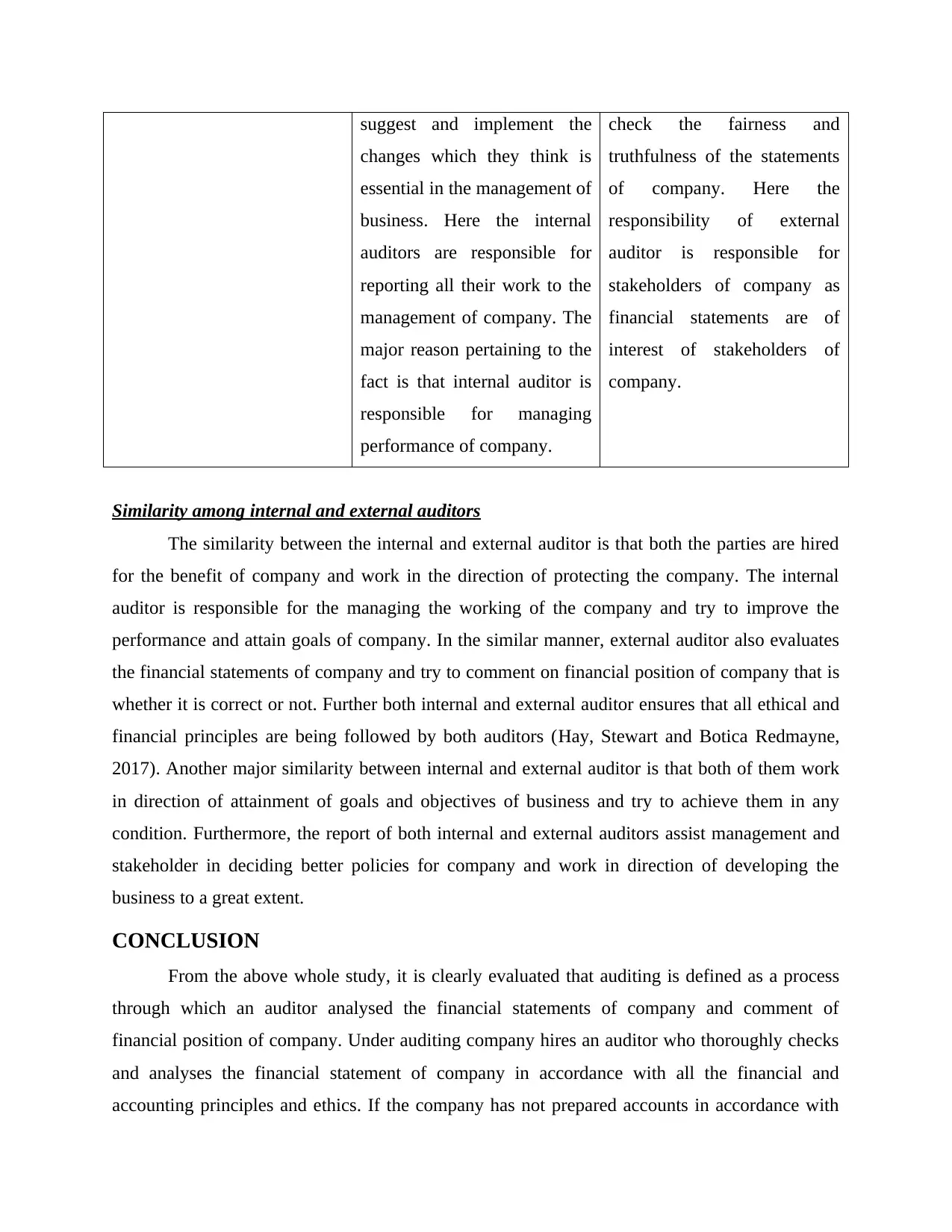
suggest and implement the
changes which they think is
essential in the management of
business. Here the internal
auditors are responsible for
reporting all their work to the
management of company. The
major reason pertaining to the
fact is that internal auditor is
responsible for managing
performance of company.
check the fairness and
truthfulness of the statements
of company. Here the
responsibility of external
auditor is responsible for
stakeholders of company as
financial statements are of
interest of stakeholders of
company.
Similarity among internal and external auditors
The similarity between the internal and external auditor is that both the parties are hired
for the benefit of company and work in the direction of protecting the company. The internal
auditor is responsible for the managing the working of the company and try to improve the
performance and attain goals of company. In the similar manner, external auditor also evaluates
the financial statements of company and try to comment on financial position of company that is
whether it is correct or not. Further both internal and external auditor ensures that all ethical and
financial principles are being followed by both auditors (Hay, Stewart and Botica Redmayne,
2017). Another major similarity between internal and external auditor is that both of them work
in direction of attainment of goals and objectives of business and try to achieve them in any
condition. Furthermore, the report of both internal and external auditors assist management and
stakeholder in deciding better policies for company and work in direction of developing the
business to a great extent.
CONCLUSION
From the above whole study, it is clearly evaluated that auditing is defined as a process
through which an auditor analysed the financial statements of company and comment of
financial position of company. Under auditing company hires an auditor who thoroughly checks
and analyses the financial statement of company in accordance with all the financial and
accounting principles and ethics. If the company has not prepared accounts in accordance with
changes which they think is
essential in the management of
business. Here the internal
auditors are responsible for
reporting all their work to the
management of company. The
major reason pertaining to the
fact is that internal auditor is
responsible for managing
performance of company.
check the fairness and
truthfulness of the statements
of company. Here the
responsibility of external
auditor is responsible for
stakeholders of company as
financial statements are of
interest of stakeholders of
company.
Similarity among internal and external auditors
The similarity between the internal and external auditor is that both the parties are hired
for the benefit of company and work in the direction of protecting the company. The internal
auditor is responsible for the managing the working of the company and try to improve the
performance and attain goals of company. In the similar manner, external auditor also evaluates
the financial statements of company and try to comment on financial position of company that is
whether it is correct or not. Further both internal and external auditor ensures that all ethical and
financial principles are being followed by both auditors (Hay, Stewart and Botica Redmayne,
2017). Another major similarity between internal and external auditor is that both of them work
in direction of attainment of goals and objectives of business and try to achieve them in any
condition. Furthermore, the report of both internal and external auditors assist management and
stakeholder in deciding better policies for company and work in direction of developing the
business to a great extent.
CONCLUSION
From the above whole study, it is clearly evaluated that auditing is defined as a process
through which an auditor analysed the financial statements of company and comment of
financial position of company. Under auditing company hires an auditor who thoroughly checks
and analyses the financial statement of company in accordance with all the financial and
accounting principles and ethics. If the company has not prepared accounts in accordance with
Secure Best Marks with AI Grader
Need help grading? Try our AI Grader for instant feedback on your assignments.
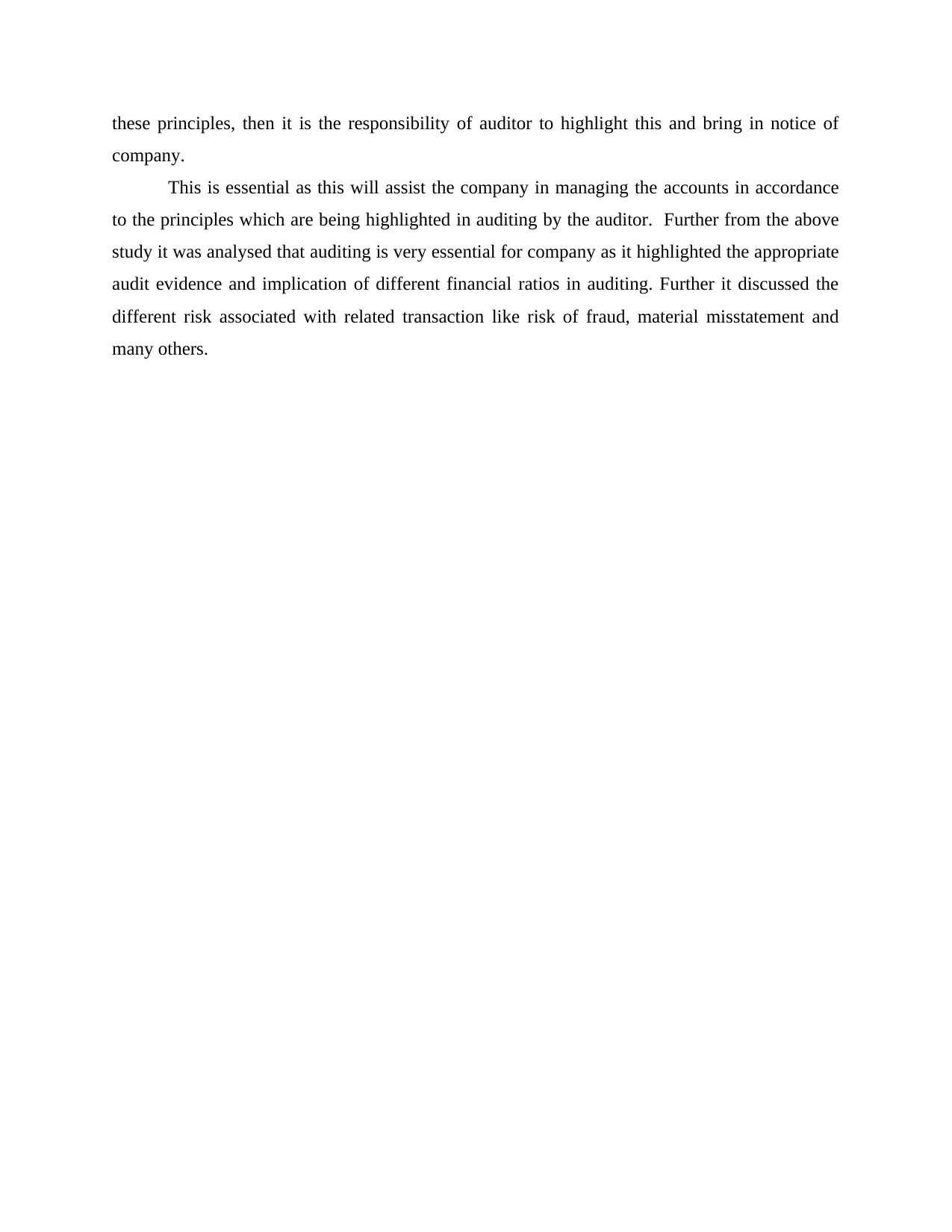
these principles, then it is the responsibility of auditor to highlight this and bring in notice of
company.
This is essential as this will assist the company in managing the accounts in accordance
to the principles which are being highlighted in auditing by the auditor. Further from the above
study it was analysed that auditing is very essential for company as it highlighted the appropriate
audit evidence and implication of different financial ratios in auditing. Further it discussed the
different risk associated with related transaction like risk of fraud, material misstatement and
many others.
company.
This is essential as this will assist the company in managing the accounts in accordance
to the principles which are being highlighted in auditing by the auditor. Further from the above
study it was analysed that auditing is very essential for company as it highlighted the appropriate
audit evidence and implication of different financial ratios in auditing. Further it discussed the
different risk associated with related transaction like risk of fraud, material misstatement and
many others.
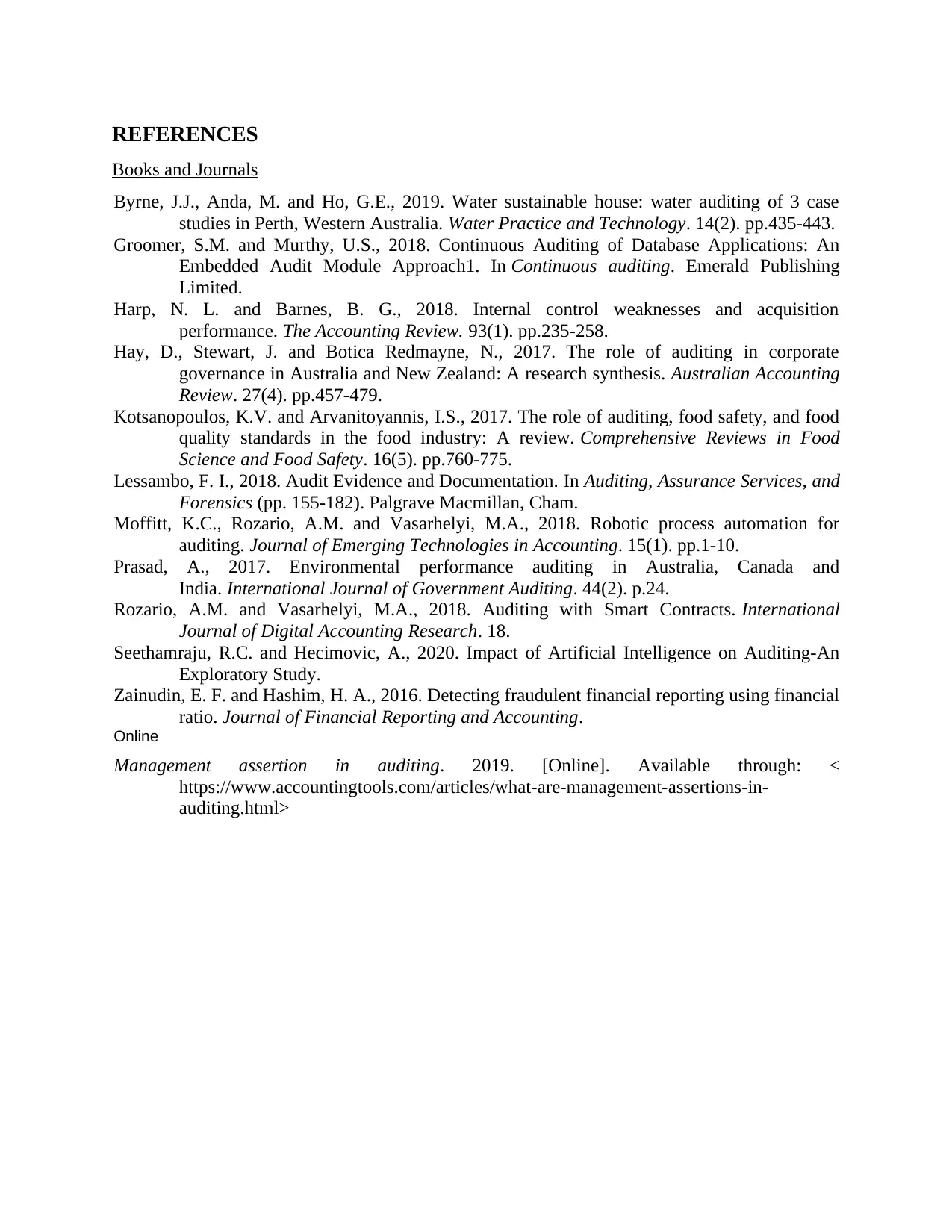
REFERENCES
Books and Journals
Byrne, J.J., Anda, M. and Ho, G.E., 2019. Water sustainable house: water auditing of 3 case
studies in Perth, Western Australia. Water Practice and Technology. 14(2). pp.435-443.
Groomer, S.M. and Murthy, U.S., 2018. Continuous Auditing of Database Applications: An
Embedded Audit Module Approach1. In Continuous auditing. Emerald Publishing
Limited.
Harp, N. L. and Barnes, B. G., 2018. Internal control weaknesses and acquisition
performance. The Accounting Review. 93(1). pp.235-258.
Hay, D., Stewart, J. and Botica Redmayne, N., 2017. The role of auditing in corporate
governance in Australia and New Zealand: A research synthesis. Australian Accounting
Review. 27(4). pp.457-479.
Kotsanopoulos, K.V. and Arvanitoyannis, I.S., 2017. The role of auditing, food safety, and food
quality standards in the food industry: A review. Comprehensive Reviews in Food
Science and Food Safety. 16(5). pp.760-775.
Lessambo, F. I., 2018. Audit Evidence and Documentation. In Auditing, Assurance Services, and
Forensics (pp. 155-182). Palgrave Macmillan, Cham.
Moffitt, K.C., Rozario, A.M. and Vasarhelyi, M.A., 2018. Robotic process automation for
auditing. Journal of Emerging Technologies in Accounting. 15(1). pp.1-10.
Prasad, A., 2017. Environmental performance auditing in Australia, Canada and
India. International Journal of Government Auditing. 44(2). p.24.
Rozario, A.M. and Vasarhelyi, M.A., 2018. Auditing with Smart Contracts. International
Journal of Digital Accounting Research. 18.
Seethamraju, R.C. and Hecimovic, A., 2020. Impact of Artificial Intelligence on Auditing-An
Exploratory Study.
Zainudin, E. F. and Hashim, H. A., 2016. Detecting fraudulent financial reporting using financial
ratio. Journal of Financial Reporting and Accounting.
Online
Management assertion in auditing. 2019. [Online]. Available through: <
https://www.accountingtools.com/articles/what-are-management-assertions-in-
auditing.html>
Books and Journals
Byrne, J.J., Anda, M. and Ho, G.E., 2019. Water sustainable house: water auditing of 3 case
studies in Perth, Western Australia. Water Practice and Technology. 14(2). pp.435-443.
Groomer, S.M. and Murthy, U.S., 2018. Continuous Auditing of Database Applications: An
Embedded Audit Module Approach1. In Continuous auditing. Emerald Publishing
Limited.
Harp, N. L. and Barnes, B. G., 2018. Internal control weaknesses and acquisition
performance. The Accounting Review. 93(1). pp.235-258.
Hay, D., Stewart, J. and Botica Redmayne, N., 2017. The role of auditing in corporate
governance in Australia and New Zealand: A research synthesis. Australian Accounting
Review. 27(4). pp.457-479.
Kotsanopoulos, K.V. and Arvanitoyannis, I.S., 2017. The role of auditing, food safety, and food
quality standards in the food industry: A review. Comprehensive Reviews in Food
Science and Food Safety. 16(5). pp.760-775.
Lessambo, F. I., 2018. Audit Evidence and Documentation. In Auditing, Assurance Services, and
Forensics (pp. 155-182). Palgrave Macmillan, Cham.
Moffitt, K.C., Rozario, A.M. and Vasarhelyi, M.A., 2018. Robotic process automation for
auditing. Journal of Emerging Technologies in Accounting. 15(1). pp.1-10.
Prasad, A., 2017. Environmental performance auditing in Australia, Canada and
India. International Journal of Government Auditing. 44(2). p.24.
Rozario, A.M. and Vasarhelyi, M.A., 2018. Auditing with Smart Contracts. International
Journal of Digital Accounting Research. 18.
Seethamraju, R.C. and Hecimovic, A., 2020. Impact of Artificial Intelligence on Auditing-An
Exploratory Study.
Zainudin, E. F. and Hashim, H. A., 2016. Detecting fraudulent financial reporting using financial
ratio. Journal of Financial Reporting and Accounting.
Online
Management assertion in auditing. 2019. [Online]. Available through: <
https://www.accountingtools.com/articles/what-are-management-assertions-in-
auditing.html>
1 out of 12
Related Documents
Your All-in-One AI-Powered Toolkit for Academic Success.
+13062052269
info@desklib.com
Available 24*7 on WhatsApp / Email
![[object Object]](/_next/static/media/star-bottom.7253800d.svg)
Unlock your academic potential
© 2024 | Zucol Services PVT LTD | All rights reserved.




